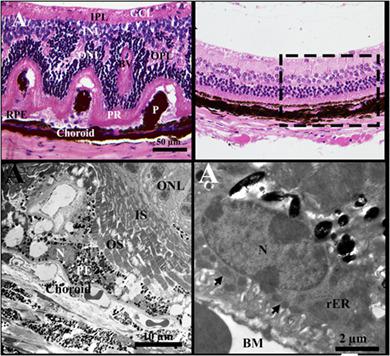当前位置:
X-MOL 学术
›
Microsc. Res. Tech.
›
论文详情
Our official English website, www.x-mol.net, welcomes your feedback! (Note: you will need to create a separate account there.)
Retinal characterization in the eyes of two bats endemic in the Egyptian fauna, the Egyptian fruit bat (Rousettus aegyptiacus) and insectivorous bat (Pipistrellus kuhlii), using the light microscope and transmission electron microscope
Microscopy Research and Technique ( IF 2.5 ) Pub Date : 2020-08-17 , DOI: 10.1002/jemt.23530 Asmaa Aboelnour 1, 2 , Ahmed E Noreldin 1 , Diaa Massoud 3, 4 , Mohamed M A Abumandour 5
Microscopy Research and Technique ( IF 2.5 ) Pub Date : 2020-08-17 , DOI: 10.1002/jemt.23530 Asmaa Aboelnour 1, 2 , Ahmed E Noreldin 1 , Diaa Massoud 3, 4 , Mohamed M A Abumandour 5
Affiliation

|
Bats are the only mammals that can fly in the dark without eye usage. This study was conducted to describe the structural and functional adaptations of the retina of two bats very common in the Egyptian fauna having a different lifestyle: the Egyptian fruit bat (Rousettus aegyptiacus) and insectivorous bat (Pipistrellus kuhlii). Seven eyes were collected from adult individuals of each species. Examination of the retina using a light microscope and a transmission electron microscope was carried out. The retina of P. kuhlii was thicker than that of R. aegyptiacus, which had many projections extended from the choroid layer into retina forming papillae. Despite rods being dominant in retinae of both species, cone photoreceptors were encountered in both retinae. The outer plexiform layer of R. aegyptiacus was arranged into islets between the outer nuclear layer produced differences in its thickness. However, the retina of P. kuhlii showed a normal arrangement of retinal structure. The retinal pigment epithelium of both bat species consists of a single layer of the cuboidal cells with a round to oval vesicular nuclei, which showed a lack of pigmentation in R. aegyptiacus and poor pigmentation in the P. kuhlii. In conclusion, our investigation detected many structural and ultrastructural differences between the two bat species. The presence of many projections protruded from the choroid layer of R. aegyptiacus retina is considered the most characteristic difference between the retinae of R. aegyptiacus and P. kuhlii.
中文翻译:

使用光学显微镜和透射电子显微镜在埃及动物区系中两只特有的蝙蝠,埃及果蝠(Rousettus aegyptiacus)和食虫蝙蝠(Pipistrellus kuhlii)眼中的视网膜特征
蝙蝠是唯一不用眼睛就能在黑暗中飞行的哺乳动物。进行这项研究的目的是描述在具有不同生活方式的埃及动物群中非常常见的两种蝙蝠的视网膜结构和功能适应性:埃及果蝠(Rousettus aegyptiacus)和食虫蝙蝠(Pipistrellus kuhlii)。从每个物种的成年个体收集七只眼睛。使用光学显微镜和透射电子显微镜对视网膜进行检查。kuhlii的视网膜比埃及古埃及杆菌的视网膜厚从脉络膜层延伸到视网膜形成乳头的突起物很多。尽管杆在两个物种的视网膜中占主导,但是在两个视网膜中都遇到视锥细胞感光器。埃及罗非鱼的外部丛状层被排列成胰岛,在外部核层之间产生了厚度差异。但是,库氏疟原虫的视网膜显示出正常的视网膜结构排列。两种蝙蝠的视网膜色素上皮均由单层立方状细胞组成,具有圆形至卵圆形的水泡核,这表明埃及埃及小球藻缺乏色素沉着,而库氏疟原虫的色素沉着较差。总之,我们的研究发现了两种蝙蝠之间的许多结构和超微结构差异。从埃及埃及视网膜的脉络膜层突出的许多突起的存在被认为是埃及埃及鼻视网膜与假单胞菌视网膜之间的最特征差异。
更新日期:2020-10-26
中文翻译:

使用光学显微镜和透射电子显微镜在埃及动物区系中两只特有的蝙蝠,埃及果蝠(Rousettus aegyptiacus)和食虫蝙蝠(Pipistrellus kuhlii)眼中的视网膜特征
蝙蝠是唯一不用眼睛就能在黑暗中飞行的哺乳动物。进行这项研究的目的是描述在具有不同生活方式的埃及动物群中非常常见的两种蝙蝠的视网膜结构和功能适应性:埃及果蝠(Rousettus aegyptiacus)和食虫蝙蝠(Pipistrellus kuhlii)。从每个物种的成年个体收集七只眼睛。使用光学显微镜和透射电子显微镜对视网膜进行检查。kuhlii的视网膜比埃及古埃及杆菌的视网膜厚从脉络膜层延伸到视网膜形成乳头的突起物很多。尽管杆在两个物种的视网膜中占主导,但是在两个视网膜中都遇到视锥细胞感光器。埃及罗非鱼的外部丛状层被排列成胰岛,在外部核层之间产生了厚度差异。但是,库氏疟原虫的视网膜显示出正常的视网膜结构排列。两种蝙蝠的视网膜色素上皮均由单层立方状细胞组成,具有圆形至卵圆形的水泡核,这表明埃及埃及小球藻缺乏色素沉着,而库氏疟原虫的色素沉着较差。总之,我们的研究发现了两种蝙蝠之间的许多结构和超微结构差异。从埃及埃及视网膜的脉络膜层突出的许多突起的存在被认为是埃及埃及鼻视网膜与假单胞菌视网膜之间的最特征差异。



























 京公网安备 11010802027423号
京公网安备 11010802027423号